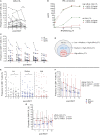Cytomegalovirus-Specific CD8+ T-Cells With Different T-Cell Receptor Affinities Segregate T-Cell Phenotypes and Correlate With Chronic Graft-Versus-Host Disease in Patients Post-Hematopoietic Stem Cell Transplantation
- PMID: 29692783
- PMCID: PMC5903031
- DOI: 10.3389/fimmu.2018.00760
Cytomegalovirus-Specific CD8+ T-Cells With Different T-Cell Receptor Affinities Segregate T-Cell Phenotypes and Correlate With Chronic Graft-Versus-Host Disease in Patients Post-Hematopoietic Stem Cell Transplantation
Abstract
Virus-specific T-cell responses are crucial to control cytomegalovirus (CMV) infections/reactivation in immunocompromised individuals. Adoptive cellular therapy with CMV-specific T-cells has become a viable treatment option. High-affinity anti-viral cellular immune responses are associated with improved long-term immune protection against CMV infection. To date, the characterization of high-affinity T-cell responses against CMV has not been achieved in blood from patients after allogeneic hematopoietic stem cell transplantation (HSCT). Therefore, the purpose of this study was to describe and analyze the phenotype and clinical impact of different CMV-specific CD8+ cytotoxic T-lymphocytes (CMV-CTL) classes based on their T-cell receptor (TCR) affinity. T-cells isolated from 23 patients during the first year following HSCT were tested for the expression of memory markers, programmed cell death 1 (PD-1), as well as TCR affinity, using three different HLA-A*02:01 CMVNLVPMVATV-Pp65 tetramers (wild-type, a245v and q226a mutants). High-affinity CMV-CTL defined by q226a tetramer binding, exhibited a higher frequency in CD8+ T-cells in the first month post-HSCT and exhibited an effector memory phenotype associated with strong PD-1 expression as compared to the medium- and low-affinity CMV-CTLs. High-affinity CMV-CTL was found at higher proportion in patients with chronic graft-versus-host disease (p < 0.001). This study provides a first insight into the detailed TCR affinities of CMV-CTL. This may be useful in order to improve current immunotherapy protocols using isolation of viral-specific T-cell populations based on their TCR affinity.
Keywords: T-cell; T-cell receptor affinity; cytomegalovirus; cytomegalovirus-specific CD8+ cytotoxic T-lymphocytes; hematopoietic stem cell transplantation; programmed cell death-1; tetramers.
Figures




Similar articles
-
Protective immunity transferred by infusion of cytomegalovirus-specific CD8(+) T cells within donor grafts: its associations with cytomegalovirus reactivation following unmanipulated allogeneic hematopoietic stem cell transplantation.Biol Blood Marrow Transplant. 2010 Jul;16(7):994-1004. doi: 10.1016/j.bbmt.2010.02.007. Epub 2010 Feb 16. Biol Blood Marrow Transplant. 2010. PMID: 20167279
-
Strong and sustained effector function of memory- versus naïve-derived T cells upon T-cell receptor RNA transfer: implications for cellular therapy.Eur J Immunol. 2012 Dec;42(12):3442-53. doi: 10.1002/eji.201242666. Epub 2012 Oct 1. Eur J Immunol. 2012. PMID: 22930221
-
Tetramer monitoring to assess risk factors for recurrent cytomegalovirus reactivation and reconstitution of antiviral immunity post allogeneic hematopoietic stem cell transplantation.Transpl Infect Dis. 2011 Jun;13(3):222-36. doi: 10.1111/j.1399-3062.2011.00626.x. Epub 2011 May 18. Transpl Infect Dis. 2011. PMID: 21585633
-
The immune response to cytomegalovirus in allogeneic hematopoietic stem cell transplant recipients.Cell Mol Life Sci. 2015 Nov;72(21):4049-62. doi: 10.1007/s00018-015-1986-z. Epub 2015 Jul 15. Cell Mol Life Sci. 2015. PMID: 26174234 Free PMC article. Review.
-
CMV-specific immune reconstitution following allogeneic stem cell transplantation.Virulence. 2016 Nov 16;7(8):967-980. doi: 10.1080/21505594.2016.1221022. Epub 2016 Aug 9. Virulence. 2016. PMID: 27580355 Free PMC article. Review.
Cited by
-
Allogeneic stem cell transplantation in second complete remission for core binding factor acute myeloid leukemia: a study from the Acute Leukemia Working Party of the European Society for Blood and Marrow Transplantation.Haematologica. 2020 Jun;105(6):1723-1730. doi: 10.3324/haematol.2019.222810. Epub 2019 Aug 22. Haematologica. 2020. PMID: 31439677 Free PMC article.
-
The impact of inflationary cytomegalovirus-specific memory T cells on anti-tumour immune responses in patients with cancer.Immunology. 2018 Nov;155(3):294-308. doi: 10.1111/imm.12991. Epub 2018 Sep 10. Immunology. 2018. PMID: 30098205 Free PMC article. Review.
-
Different recovery patterns of CMV-specific and WT1-specific T cells in patients with acute myeloid leukemia undergoing allogeneic hematopoietic cell transplantation: Impact of CMV infection and leukemia relapse.Front Immunol. 2023 Feb 7;13:1027593. doi: 10.3389/fimmu.2022.1027593. eCollection 2022. Front Immunol. 2023. PMID: 36824620 Free PMC article.
-
Antibody-mediated delivery of a viral MHC-I epitope into the cytosol of target tumor cells repurposes virus-specific CD8+ T cells for cancer immunotherapy.Mol Cancer. 2022 Apr 22;21(1):102. doi: 10.1186/s12943-022-01574-0. Mol Cancer. 2022. PMID: 35459256 Free PMC article.
-
T-cell receptor repertoire of cytomegalovirus-specific cytotoxic T-cells after allogeneic stem cell transplantation.Sci Rep. 2020 Dec 17;10(1):22218. doi: 10.1038/s41598-020-79363-2. Sci Rep. 2020. PMID: 33335252 Free PMC article.
References
Publication types
MeSH terms
Substances
LinkOut - more resources
Full Text Sources
Other Literature Sources
Medical
Molecular Biology Databases
Research Materials

